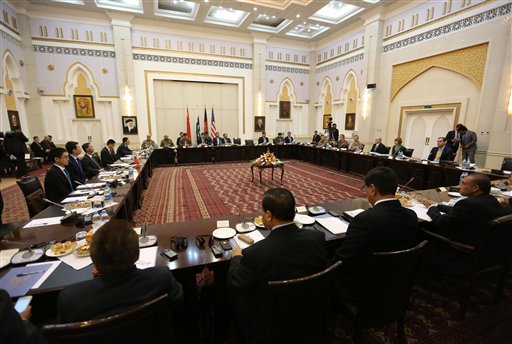Afghanistan, but less confusing
Read on for a basic explanation of America’s longest war.

Delegations from Afghanistan, Pakistan, The United States of America and China discuss a road map for ending the war with the Taliban at the Presidential Palace in Kabul, Afghanistan, Tuesday, Feb. 23, 2016. An Afghan official says talks in Kabul between representatives of four countries trying to end Afghanistan’s war with the Taliban are likely to set a date for a face-to-face meeting between the two sides. (AP Photo/Rahmat Gul)
In light of the current negotiations between the U.S. and the Taliban, here’s a brief recap of the ongoing conflict in Afghanistan.
Who is fighting?
- A coalition of American, Canadian, British, German, Australian, etc. forces, backed by NATO
- Afghan security forces (allied with the coalition)
- The Taliban
- ISIS, al-Qaeda, and other terrorist organizations
- Local militants
How long has this been going on?
The U.S. has been involved for 17 years so far. But the country has a lengthy and complex history of armed conflict, most of which kicked off in the aftermath of the Saur Revolution (1978). This coup established a communist government in Afghanistan called the People’s Democratic Party of Afghanistan (PDPA). Its policies eventually tilted to the far left, upending conservative social norms and resulting in another coup attempt by Afghan Mujahideen rebels (1979). The Soviet Union invaded to support the weakened PDPA – and to expand their influence in Asia. The U.S. didn’t send any troops, but they supported the rebels in order to mitigate Soviet influence in the region. Soviet troops left Afghanistan in 1988. Afghanistan deteriorated into an ideological and militaristic battleground, leaving a power vacuum that enabled the Taliban regime to emerge.
Why are Americans there, and what are they doing?
President Bush sent American troops to Afghanistan in the aftermath of 9/11 because of the Taliban’s penchant for harboring terrorists (2001). U.S. support of the Afghan government (which controls much of the country’s central territory) resulted in tremendous advances for the rights of women, amongst other things. However, not all Afghans welcome foreign troops, and many view U.S. presence as an affront to local culture. For this reason, as well as the lack of a single dominant group in Afghanistan, the fighting is unlikely to stop soon.
Who is participating in negotiations?
This month, the U.S. met with the Taliban in Qatar. While the Taliban doesn’t officially govern Afghanistan, the group holds vast amounts of territory and controls the daily lives of many Afghan citizens. The parties are working towards a deal in which foreign troops would leave the country. In exchange, the Taliban must agree to a ceasefire and promise to stop cooperating with terrorist organizations.
How does the Afghan government feel about this?
Generally, the Afghan government welcomes the presence of foreign troops because it isn’t strong enough to govern on its own, and mutual distrust between the Afghan government and the Taliban will probably interfere with negotiations.


Rachel • Feb 8, 2019 at 12:33 pm
Love it!! Please make this a series.
Yusuf Amin • Feb 6, 2019 at 8:05 am
No doubt, the conflict’s very presence can still teach us in the present day how else to adapt through any scenario (notwithstanding the unlikelyhood) while re-affirming the lessons best used from the Iraq war. A good thanks towards you for having this brought up.
anonymous • Feb 2, 2019 at 3:54 am
I love your writing. Keep it up!